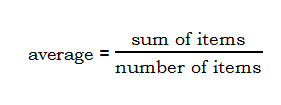 Here’s a whirlwind tour of one of the most frequently tested sets of concepts on the GMAT Quantitative section. You don’t have to be an expert on statistics: a little goes a long way.
Here’s a whirlwind tour of one of the most frequently tested sets of concepts on the GMAT Quantitative section. You don’t have to be an expert on statistics: a little goes a long way.
The Mean
The mean is just the ordinary average: add up all the items on the list, and divide by the number of items. As a formula, that’s
Notice, we can rewrite that as: (sum of items) = average*(number of items). Rewritten in that form, it becomes one of the most powerful formulas on the GMAT, see this post: https://magoosh.com/gmat/2012/gmat-averages-and-sums-formulas/ for more details.
The Median
When we put the list in ascending order, the median is the middle. If there are an odd number of items on the list, the middle item equals the median: for example, in the seven-element set {3, 5, 7, 9, 13, 15, 17}, the median is the fourth number, 9. If there are an even number of items on the list, then the median is the average of the two middle numbers; for example, in the eight-element set {3, 5, 7, 9, 13, 15, 17, 17}, the median is 11 (the average of the fourth & fifth entries, 9 and 13). Notice: when the number of items on the list is even, the median can equal a number not on the list. Numbers above and below the median can be equal to the median, and that doesn’t change the fact that it’s a median; for example, the median of the set {1, 3, 3, 3, 3, 3, 74, 89, 312} is just 3, the fifth number of that nine-element set.
Range
The GMAT loves this one, because it’s so simple. The range is the difference between the maximum value and the minimum value. In the set {3, 5, 7, 9, 13, 15, 17}, the range = 17 – 3 = 14. In the set {1, 3, 3, 3, 3, 3, 74, 89, 312}, the range = 312 – 1 = 311.
Standard Deviation
The range is a measure of the spread from the highest to the lowest value, but it doesn’t “feel” the numbers in between. The standard deviation is also a measure of spread, that is to say, an indication of how far apart the numbers on the list are from each other. Like the mean and unlike the range, the standard deviation “feels” every number on the list. It has a technical definition that we can forego here; the majority of appearances of standard deviation on the GMAT revolve around a few simple ideas about it.
a) If all the entries of the list are equal, the standard deviation = 0. In other words, they don’t deviate at all, because they’re all the same.
b) If you add/subtract a constant to/from every number on a list, that doesn’t change the standard deviation at all. It’s just like taking the batch of data points and sliding them up or down the number line: that process doesn’t change how far apart they are from each other.
c) If you multiply/divide a list by a constant, then you also multiply/divide the standard deviation by this constant.
I’ll add an additional rule that really could only come into play in a very difficult upper-700s question:
d) If all the entries are the same distance from the mean, that distance is the standard deviation. For example, in the set {3, 3, 3, 7, 7, 7}, the mean = 5, and every number “deviates” from the mean by exactly two units, so the standard deviation = 2.
If you master these simple ideas, you will dominate on Descriptive Statistics in the GMAT Quantitative section. Here are some practice questions:
1) https://gmat.magoosh.com/questions/112
2) https://gmat.magoosh.com/questions/938
3) https://gmat.magoosh.com/questions/937
This post was written by Mike McGarry, GMAT expert at Magoosh, and originally posted here.

